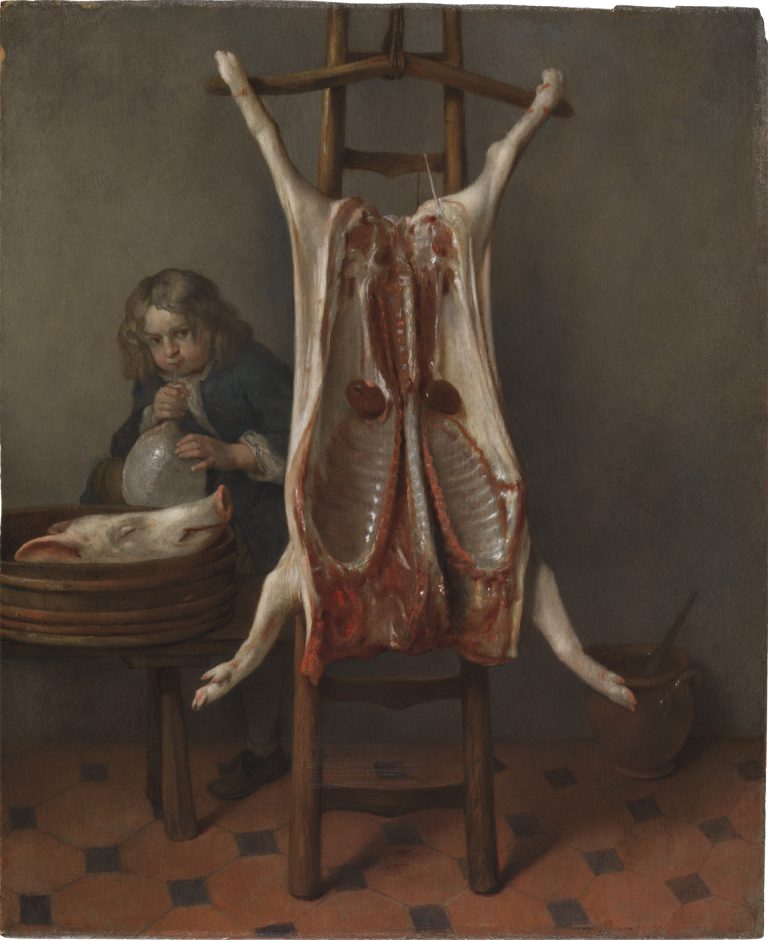Seventeenth-century Netherlandish images of slaughtered oxen and pigs have their roots in medieval depictions of the labors of the months, specifically November, the peak slaughtering season. The theme was given new life in the mid-sixteenth century through the works of the Flemish painters Pieter Aertsen (1508–75) and Joachim Beuckelaer (ca. 1533–ca. 1574), who incorporated slaughtered and disemboweled animals in their vivid renderings of abundantly supplied market stalls, and also explored the theme as an independent motif.1 The earliest instances of the motif in the Northern Netherlands come only in the seventeenth century, possibly introduced by immigrants from the south. During the early 1640s, the theme of the slaughtered animal—split, splayed, and suspended from the rungs of a wooden ladder—was taken up by (among others) Adriaen (1610–85) and Isack (1621–49) van Ostade, who typically situated the event in the dark and cavernous interior of a barn, stable, or kitchen.2 A number of artists in Rembrandt’s orbit—Gerbrand van den Eeckhout (1621–74), Barent Fabritius (1624–73) (fig 1), Nicolaes Maes (1634–93), and Jan Victors (1619–after 1676)—treated the subject during the 1640s and 1650s, as, of course, did Rembrandt himself, most famously in his Slaughtered Ox of 1655 in the Musée du Louvre (fig 2).3 In 1666, even the stylish Amsterdam portrait painter Bartolomeus van der Helst (1613–70) featured the carcass of a pig, flanked by a vegetable seller and a group of children, suspended before a view of Amsterdam’s Nieuwmarkt.4 In 1668, Van der Helst’s painting was the inspiration for Michiel van Musscher’s The Haarlemmerdijk with a Pig on a Stepladder;5 interestingly, these last paintings return the theme to the urban market context developed by Aertsen and Beuckelaer more than a century before.
For obvious reasons, in Dutch genre paintings the motif of the slaughtered ox or pig is usually considered as a vanitas allegory.6 Most seventeenth-century (and earlier) depictions include one or more children, who inflate the animal’s bladder for use as a toy. This motif is a charmingly mundane manifestation of Homo bulla, which likens the fragility of human life to a delicate soap bubble. A print in a book of emblems published in 1712 shows children playing with an inflated pig’s bladder, accompanied by a verse that begins: “How hard you blow, o child of the world! You catch nothing but wind. The world is nothing more than a bladder filled with air” (fig 3).7 The slaughtered pig could also represent avarice: folk tradition equated pigs gorging themselves with the behavior of misers; only after death was their usefulness revealed (in the form of ample food from the former or a substantial inheritance via the latter).8
The present painting is simply composed, with the spread and eviscerated carcass displayed frontally at the center and its severed head resting in a shallow wooden tub on a bench to the left. Most of the organs have been removed from the body, except for the dark kidneys and the anus. Peering out from behind the carcass is a young boy who blows air through a straw into the pig’s bladder.
Earlier literature describes The Slaughtered Pig as being signed and dated either 1660 or 1662,9 but no inscriptions are now visible on the painting.10 Although the rustic subject matter aligns with Caspar Netscher’s early depictions of barn and kitchen scenes—compare for example, Chaff Cutter with Woman and Child in the Philadelphia Museum of Art, 1659; or Knife Grinder in Turin (fig 4), dated 166211—the relatively broad and imprecise painting style is atypical for the artist. Still, the productions of Netscher’s early career (from the mid-1650s to about 1662) were highly variable, exploring a range of scale and technique and with evidently sophisticated works sometimes predating those less ambitious in design or execution.12 Unless or until a more viable alternative can be presented, the current attribution of the picture to Netscher can reasonably be maintained.
